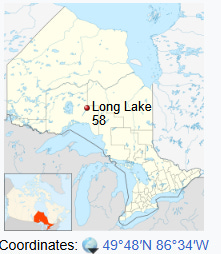CBC Spews More Indian Residential School Distortion on Percy Onabigon – Part Three
Repeaters, not Reporters.
By Michelle Stirling ©2025 with files and research by Nina Green.
The CBC story reports Claire Onabigon saying that it was in 1944 when Percy was sent away.
"My mother remembers in November they were out at recess, and the kids came running to her and told her that Percy had gone to the McKellar Hospital," recalled Claire. "My mum said that was the last time they ever saw him."
There is no record of Claire’s mother, Bertha, being enrolled in the residential school that year and no record of Percy being enrolled. Thus, it would seem that this incident took place on the schoolyard of the day school on the Long Lake reserve. In this case, Percy was not an Indian Residential School student, ever.
If we go with Kimberly Murray’s claim of Percy Nabigon being ‘taken away’ to St. Joseph’s at age 6, it would clearly be a case of mercy and charity. The minimum age of enrollment was 7 years old, unless the child was orphaned, the family destitute or the child at risk of neglect or domestic violence. Caring for a partially paralyzed epileptic in the 1940’s at home in a small native community would have been very difficult and demanding. If we go with the family’s claim that Percy attended at age 8 with his sister and brothers, then it was clearly not a case of education. There was a day school on reserve that all of these children could have and did attend. And if Bertha’s memories are from the day school, then it means that Canadian taxpayers have been defrauded in the payment of the $45,000 to repatriate Percy’s body, on the premise that:
A) Percy was taken away by the government and forced to attend St. Joseph’s Indian Residential School
B) The government imposed institutional care upon him without the family’s knowledge or consent
C) The government wronged the family for not ensuring his body was sent home
D) Thus, compensation of the repatriation costs was due.
Indeed, in the CBC story, Claire Onabigon is quoted as saying:
"You chose to put him in an institution, to take him from his family, to take him from everything that he knew, and you hid him until he died — so it's your responsibility to bring him back," she continued, referring to the Canadian government.”
In reality, the facts and evidence indicate that Percy was sent to the care facility from his home reserve because his family needed help. By 1950, Percy’s father Duncan was in a TB sanatorium for an unknown period of recovery; Percy and his siblings were effectively orphaned. Thus, it seems more likely that one or both parents arranged with the Indian Agent to get medically appropriate care for Percy, such as it was in those times, and as with many wards of the State, the family did not keep contact with him.
If Percy did go to St. Joseph’s as an interim measure, it was not as a student, as he would not have passed the medical exam; it would have simply been a charity case as Robert Carney described. Thus, Percy was not forcibly taken away, he was provided with care at no cost to the family, and his death from TB was consistent with the times, when TB was the greatest killer of all Canadians. In those times, sometimes people were buried with no marker, as TB carried a significant social stigma and this could affect the family members’ social relations. Sometimes and in some jurisdictions, the bodies of people who died of contagious, infectious diseases were not allowed to be shipped anywhere, however, we don’t know if that was the case here.
In reporting the story, CBC sets no historical context about epilepsy. Up until the 1970’s, epilepsy was a mysterious condition for which there were few remedies other than institutionalization. The daughter of Mark Twain suffered from epilepsy and died from it, despite the best care available at the time.
Harsh as this sounds by today’s standards, it was common that a family would make their loved one a ‘ward of the State’ and thus the State would provide whatever institutional care it could offer at no cost to the family.
Sometimes the families made an effort to keep in touch and visit their loved one; other families found it too difficult. The distances were often great, as was the case for Percy. In much of society, there was significant social shame in having a family member with a strange disease or disability. There were social fears that epilepsy could be contagious or genetic (though medical people knew it was not contagious), thus healthy family members might be rejected for work opportunities or marriage.
Family “skeletons” remained in the closet in those times.
In both the Kimberly Murray account and in the CBC account, much is made of the fact that the Indian Agent, Mr. J. G. Burk, was notified of where Percy was moved to, but not the family. According to this letter from Philip Phelan to Mr. Burk, Indian Agent, the Department of Indian Affairs was most interested that children attend the day school on their home reserve, which seems to contradict the claim CBC and residential school activists that children were forcibly taken to Indian Residential School.
Regarding the fact that the government did not consult further with the family, people don’t understand that Status Indians are wards of the State, to this day.
Thus, as a ward of the State, the only person required to have notice of Percy’s whereabouts was the Indian Agent. Whether or not his location was then told to the family we don’t know. Perhaps the information was passed on, but it would have been virtually meaningless to people living 1,200 kilometers away and likely forgotten over the course of 20-odd years.
It is odd that we do not hear of any letters to or from Percy and his family, which would have been an indication of an effort to keep in touch, despite the distance.
According to Wikipedia, as of January 2008, the total registered population on Long Lake #58 First Nation was 1,248 people, of which their on-Reserve population was 427. According to the 2016 census, there are about 110 houses on reserve. It doesn’t sound like an epileptic, partially paralyzed boy could have received the substantial health services and personal care required in such a small, remote location – not then, and not now.
Like the case of Marieyvonne Alaka Ukaliannuk, of Igloolik, Nunavut, which I discuss here, and which was a prominent story in Kimberly Murray’s first report “Sacred Responsibility,” the story of Percy is not framed with any historical or geographical context. As with Percy, Marieyvonne suffered from ever increasing health care needs, and thus was transferred by the federal government to more suitable facilities, which were unfortunately were farther and farther away from her home in the far north.
The recent news that Kamloops First Nation received $12 million to do field work and search for actual graves to support their claim of there being 215 bodies of children buried in the old orchard makes the distorted story of Percy Onabigon, framed ‘as if’ he was an Indian Residential School student, suspicious, in my opinion.
Kamloops First Nation reportedly spent much of the money on PR consultants and communications experts.
But now, the Indigenous rights activists who claim Canada committed genocide have an actual body, and they are sending poor Percy’s remains for forensic analysis. From the CBC story:
Percy's remains are being sent to Ontario's Forensic Pathology Service in Toronto, where an autopsy and DNA analysis will be conducted — though a forensic anthropologist who assisted with the exhumation says there are signs an autopsy has already been conducted.
The family says they were never told this, and have not been able to trace any documentation.
People like Kimberly Murray who tell us that the field of 215 markers is too sacred to dig to see if there are any coffins, graves, or human remains there, have exhumed a grave and are sending a young man’s body for an autopsy.
Indigenous activists and their allies, like settler historian, Sean Carleton, say “…they don’t owe you their children’s bodies, you have to just believe Survivors” claim there is no need to dig up a grave.
People like Kimberly Murray tell us the spirits of those deceased must not be disturbed from their resting place. Therefore, the alleged 215 unmarked graves are sacred, even though they are in a field where 2000 feet of septic trenches were dug in the 1920’s, right in the same spot that Ground Penetrating Radar (GPR) found ‘anomalies.’ Yet, these same people are very happy to have dug up Percy Onabigon’s body and after further desecrating the body in the lab of Ontario's Forensic Pathology Service, are going to ship his remains 1,200 kilometers away at taxpayers’ expense. They are trying to make out that Percy was an Indian Residential School student – that the State ‘disappeared’ him out of cruelty and genocidal intent, just as Kimberly Murray tried to frame things in her final report. So far, the documented evidence shows that the opposite is true. I discuss Murray’s ‘disappeared’ report, “Sites of Truth, Sites of Conscience” and its broader implications for its unfounded claims that children were ‘disappeared,’ here.
Watch for how this story of Percy Onabigon spins in the days and weeks to come.
As ever, CBC raises its $1.4 billion megaphone again to act as a repeater, not a reporter, inciting more public hatred and violence with its distorted reporting, devoid of historical context and unfact checked. Repeaters, not reporters.
Not facts. Not truth. And no reconciliation. And all at taxpayers’ financial and emotional expense.
May G-d forgive them. I cannot.
- 30 -












I suggest the CBC spend some of it’s executive bonus money of their research and fact checking department - if one exists…